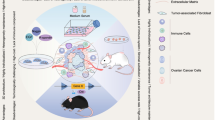Abstract
Mouse models—xenograft models, syngeneic models (directly implanted or chemically or virally induced), and genetically engineered mice (including transgenic and knockout methods) are invaluable for preclinical studies of ovarian cancer as they recapitulate the structures and microenvironments of tumors, which in vitro studies are unable to accomplish.
This chapter describes the methodology and approaches for generating various murine models currently employed in ovarian cancer research. It covers the implantation of cells from ovarian cancer cell lines into mice by intraperitoneal injection.
Access this chapter
Tax calculation will be finalised at checkout
Purchases are for personal use only
Similar content being viewed by others
References
Reid BM, Permuth JB, Sellers TA (2017) Epidemiology of ovarian cancer: a review. Cancer Biol Med 14:9–32
Chien J, Kuang R, Landen C, Shridhar V (2013) Platinum-sensitive recurrence in ovarian cancer: the role of tumor microenvironment. Front Oncol 3:251
Coleman RL, Monk BJ, Sood AK, Herzog TJ (2013) Latest research and treatment of advanced-stage epithelial ovarian cancer. Nat Rev Clin Oncol 10:211
Rescigno P, Cerillo I, Ruocco R, Condello C, De Placido S, Pensabene M (2013) New hypothesis on pathogenesis of ovarian cancer lead to future tailored approaches. Biomed Res Int 2013:852839
Torre LA, Trabert B, DeSantis CE, Miller KD, Samimi G, Runowicz CD et al (2018) Ovarian cancer statistics, 2018. CA Cancer J Clin 68:284–296
Kanchi KL, Johnson KJ, Lu C, McLellan MD, Leiserson MDM, Wendl MC et al (2014) Integrated analysis of germline and somatic variants in ovarian cancer. Nat Commun 5:1–14
Kim J, Park EY, Kim O, Schilder JM, Coffey DM, Cho C-H et al (2018) Cell origins of high-grade serous ovarian cancer. Cancers (Basel) 10:433
Seidman JD, Horkayne-Szakaly I, Haiba M, Boice CR, Kurman RJ, Ronnett BM (2004) The histologic type and stage distribution of ovarian carcinomas of surface epithelial origin. Int J Gynecol Pathol 23:41–44
Yamulla RJ, Nalubola S, Flesken-Nikitin A, Nikitin AC, Schimenti JC (2020) Most commonly mutated genes in High Grade Serous Ovarian Carcinoma are nonessential for ovarian surface epithelial stem cell transformation. bioRxiv. Cold Spring Harbor Laboratory
Szabova L, Yin C, Bupp S, Guerin TM, Schlomer JJ, Householder DB et al (2012) Perturbation of Rb, p53, and Brca1 or Brca2 cooperate in inducing metastatic serous epithelial ovarian cancer. Cancer Res 72:4141–4153
Domcke S, Sinha R, Levine DA, Sander C, Schultz N (2013) Evaluating cell lines as tumour models by comparison of genomic profiles. Nat Commun 4:1–10
Fong MY, Kakar SS (2009) Ovarian cancer mouse models: a summary of current models and their limitations. J Ovarian Res 2:12
House CD, Hernandez L, Annunziata CM (2014) Recent technological advances in using mouse models to study ovarian cancer. Front Oncol 4:26
Zhang S, Dolgalev I, Zhang T, Ran H, Levine DA, Neel BG (2019) Both fallopian tube and ovarian surface epithelium are cells-of-origin for high-grade serous ovarian carcinoma. Nat Commun 10:1–16
Maru Y, Hippo Y (2019) Current status of patient-derived ovarian cancer models. Cells 8:505
Richmond A, Su Y (2008) Mouse xenograft models vs GEM models for human cancer therapeutics. Dis Model Mech 1(2-3):78–82
Garson K, Shaw TJ, Clark KV, Yao D-S, Vanderhyden BC (2005) Models of ovarian cancer—are we there yet? Mol Cell Endocrinol 239:15–26
Magnotti E, Marasco WA (2018) The latest animal models of ovarian cancer for novel drug discovery. Expert Opin Drug Discov 13:249–257
Author information
Authors and Affiliations
Corresponding author
Editor information
Editors and Affiliations
Rights and permissions
Copyright information
© 2022 The Author(s), under exclusive license to Springer Science+Business Media, LLC, part of Springer Nature
About this protocol
Cite this protocol
Mittal, S., Gupta, P., Chaluvally-Raghavan, P., Pradeep, S. (2022). Establishment of In Vivo Ovarian Cancer Mouse Models Using Intraperitoneal Tumor Cell Injection. In: Kreeger, P.K. (eds) Ovarian Cancer. Methods in Molecular Biology, vol 2424. Humana, New York, NY. https://doi.org/10.1007/978-1-0716-1956-8_16
Download citation
DOI: https://doi.org/10.1007/978-1-0716-1956-8_16
Published:
Publisher Name: Humana, New York, NY
Print ISBN: 978-1-0716-1955-1
Online ISBN: 978-1-0716-1956-8
eBook Packages: Springer Protocols




